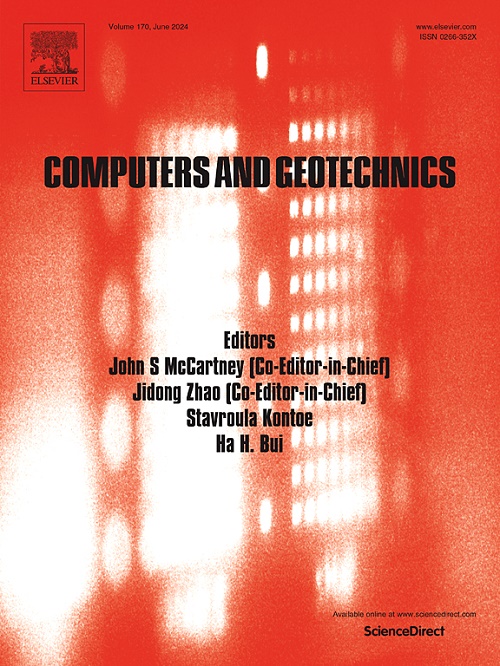非常规各向异性页岩气体流动和固体变形数值模拟
IF 6.2
1区 工程技术
Q1 COMPUTER SCIENCE, INTERDISCIPLINARY APPLICATIONS
引用次数: 0
摘要
由于页岩气藏模拟中引入了流体和固体耦合变形,地质力学对产气的影响已成为研究热点。虽然大量研究表明,地质力学效应往往会降低累积产气量,但与刚性多孔基质相比,考虑到弹塑性变形可能会在生产过程中造成额外的孔隙压实,就会出现明显的矛盾。具体来说,假设相同的初始和最终气体压力,等温过程和理想气体行为,这种额外的压实理论上应该提高最终气体产量。此外,目前广泛采用的页岩气储层模拟方法在同时模拟力学各向异性和弹塑性变形方面存在局限性。为了解决这些矛盾和挑战,本研究开发了一个内部模拟器,该模拟器基于严格的混合u/p公式,并结合了裂缝气体流动方程的一维有限元离散化,该模拟器已经过严格验证,并显示出令人满意的性能。主要的改进在于在孔隙中加入可压缩气体,而不是像水这样的稍微可压缩的流体,以及相关的数值分支。对完整页岩样品和现场压裂页岩储层进行的数值模拟不仅解决了上述矛盾,而且揭示了不同层理面取向在产气过程中塑性应变分布的一种未被报道的趋势。流体类型的影响也被强调。本文章由计算机程序翻译,如有差异,请以英文原文为准。
Numerical modeling of gas flow and solid deformation in unconventional anisotropic shale
Since coupled flow and solid deformation were introduced into shale gas reservoir simulations, the geomechanical effects on gas production have become a frequently studied topic. While numerous studies suggest that geomechanical effects tend to reduce cumulative gas production, an apparent contradiction arises when considering that elastoplastic deformation could cause additional pore compaction during production, compared to a rigid porous matrix. Specifically, assuming identical initial and final gas pressures, an isothermal process, and ideal gas behavior, such additional compaction should theoretically enhance ultimate gas production. Furthermore, widely used shale gas reservoir simulation approaches have limitations in simultaneously modeling mechanical anisotropy and elastoplastic deformation. To address these contradictions and challenges, this work develops an in-house simulator based on a rigorous mixed formulation coupled with a one-dimensional finite element discretization of the fracture gas flow equation, which has been validated rigorously and demonstrates satisfactory performance. A main improvement lies in the incorporation of a compressible gas in the pores rather than a slightly compressible fluid such as water, together with the associated numerical ramifications. Numerical simulations performed on intact shale samples and field-scale fractured shale reservoirs not only address the contradictions mentioned above but also uncover an unreported trend in the plastic strain distribution during gas production associated with different bedding plane orientations. The impact of the fluid type is also highlighted.
求助全文
通过发布文献求助,成功后即可免费获取论文全文。
去求助
来源期刊

Computers and Geotechnics
地学-地球科学综合
CiteScore
9.10
自引率
15.10%
发文量
438
审稿时长
45 days
期刊介绍:
The use of computers is firmly established in geotechnical engineering and continues to grow rapidly in both engineering practice and academe. The development of advanced numerical techniques and constitutive modeling, in conjunction with rapid developments in computer hardware, enables problems to be tackled that were unthinkable even a few years ago. Computers and Geotechnics provides an up-to-date reference for engineers and researchers engaged in computer aided analysis and research in geotechnical engineering. The journal is intended for an expeditious dissemination of advanced computer applications across a broad range of geotechnical topics. Contributions on advances in numerical algorithms, computer implementation of new constitutive models and probabilistic methods are especially encouraged.
 求助内容:
求助内容: 应助结果提醒方式:
应助结果提醒方式:


